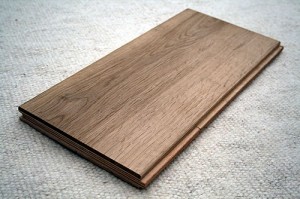Engineered Oak Flooring: A Popular Choice and For Good Reasons
Question: I’m looking to install wood flooring in my home and if possible, I’d like to do it myself. A friend suggested engineered oak flooring, but it sounds complicated. What exactly does “engineered” mean? – Emma K., Washington
Answer: Don’t worry, it doesn’t mean you need a degree in flooring to work with it. “Engineered” simply refers to the process in which the flooring is made, which involves several pieces of wood and plywood being laminated together to produce a board. The top layer is then veneered and finished to match a particular wood, such as oak. In the end, the look and feel are very similar to that of hardwood.
Indeed, engineered oak flooring possesses the same character and richness of solid wood flooring. Once installed, it’s difficult to tell the two flooring systems apart. However, there are differences between them, which you should consider when making your decision. These concern finish, moisture, resale value, and installation.
Knowing that you’d like to install the flooring yourself, let’s begin with the last in the above list: installation. The good news is, is that engineered flooring is much less difficult to install on one’s own versus traditional hardwood flooring. From measurements to sanding to finishing, engineered floorboards take care of it all, arriving in prefinished form — ready to be installed.
Engineered wood flooring is the best of both worlds–it can be either a floating floor (not attached to the subfloor) or a nailed-down floor.

Other considerations:
- Finish: As said, you won’t need to do any finishing of the boards. Once installed, they’re ready to be trodden on. By contrast, hardwood floor planks need to be measured, sanded, and once installed, finished. For the do-it-yourselfer, a more reasonable project is to install the prefinished boards of say, engineered oak flooring.
- Moisture/Heat: Because wood expands and contracts with temperature changes, it’s always possible that a wood floor could warp or swell out of shape. Oak flooring for instance, will swell if it takes on any moisture. However, engineered flooring is such that it can take heat, cold, and even a small amount of moisture. This makes it a viable option for rooms where hardwood was thought impossible, such as ground-floor rooms.
- Resale Value: As said, engineered floors look nearly identical to hardwood flooring. The difference is in the composition, which should only be a factor if you plan on reselling your home. For some buyers, a floor that isn’t solid wood may be a factor. However, this is quite possibly the only instance where an engineered floor would come up wanting.
If you’re thinking of installing engineered oak flooring yourself, keep in mind that they’re available in a variety of finishes, including oiled, lacquered, and varnished. As for the “feel” of the wood, this is based on the way in which is was processed. The main three types from least expensive to most, as well as least visually striking to most are:
- Rotary-peeled veneers
- Sliced veneers
- Sawn veneers
Depending on your budget, you’ll have to choose which is most important to you: cost vs. appearance. For such an investment, you should be certain of every aspect of your new flooring. What’s more, as the installer, you’ll also want to decide how you want to install it.
Options for installation include nail down, staple down, glue down, and floating. With a floating system, the flooring isn’t actually connected to the subfloor, which is one reason why engineered floors can be installed in most any room, as well as above radiant systems.
There’s a lot to consider, we know. We hope we didn’t overwhelm you. You can do it. Good luck on your project, and let us know how it turned out.